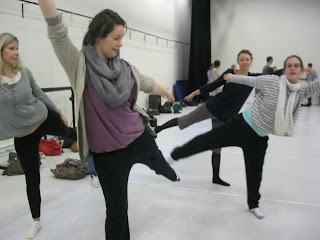Tutorial 3
What we did today…
-Firstly, we had to rate our experience
while on practicum from 1-10 (10 being the best) This gave us our stimulus.
-We then had to describe our time during
practicum in one word and then create a pose to represent. (which was the other part of our stimulus)

-Jacqui then asked us all the move around the room, counting to our stimulus number and freezing in our pose for the same amount of time (my number was 9 so I walked for 9 beats and then held my pose for 9 beats.) We moved around the room freely and practiced this.
- We then had to share our pose with a
partner and then with a group of 5 or 6. We had to teach everyone our moves and
put them all together to create a phrase of dance.
-We had to complete the piece by using
appropriate and creative transitions to move from pose to pose.
-Once we have practiced the piece, we then
added onto the piece, using the same movements but adapting it by including
contrast and a canons. As a result we had 3 parts to our piece: our original
piece, one using contrast and one using canons.
-We then combined everyone’s pieces into a
whole performance. For part of the performance, Jacqui asked us to move into
the centre and perform as a group individually before moving into a different
space to allow for other groups to perform.
-We then added on the final section of the
performance, where we marched in a circle and, one at a time, come into the
centre and pose in our placement pose until everyone has stopped (this freeze
frame becomes our final pose.)
-We started by walking freely and posing in
our poses for the 9 beats (in my case)
-we then marched in a circle until we
reached our first position to start our group pieces.
-We then did our entire piece (original,
contrast and canons)
-The group then swaps positions with
another group to allow them to perform.
-After everyone has performed individually,
we do the entire piece once more.
-Lastly we marched into a circle again and
slowing, one by one, move into the centre and form our final pose.
The Creative Process
ISARE
Improvisation- trialing ideas
Selection- selecting the movement
Arrange- arrange your movement
Refinement- refine and rehearse to remember
Evaluate- do you like what you’ve done?
Stimulus, Expressive Intention and Theme
Movement
Vocabulary
Space, Time and Energy
To finish off the lesson, we made our way
outside to ’react’ to the environment. Jacqui asked us to explore our
relationship with the environment, linking ourselves to the earth’s elements;
wind, water, fire and earth.
We practiced tai chi and yoga.
We explored the space by moving in a line
and taking on characteristics of the environment.

Applying it to a mainstream
classroom

Applying it to a mainstream
classroom
Different Levels
Early Years: Because our tutorials are long, I would not expect to teach the entire lesson in a mainstream classroom context. I do feel that you could teach elements of this lesson to a younger audience, but asking students who are in Prep, 1, 2 will struggle to create their own pieces. The first part of the lesson where we had to walk around for 9 counts and hold our positions would work wonderfully when teaching a younger grade as you can integrate the mathematical concepts and have the students practicing number patterns. VCAA (2012) explains that at a Level 1 Standard, students ' express and
communicate experiences, observations, ideas and feelings about themselves and
their world', which we did today when given stimuli and a theme to base our pieces on.
Level 2: As said previously I feel that asking students to create such a large piece, remembering the order of the performance is asking too much of students in Level 2, but a smaller activity would work fantastically. VCAA (2012) also states that 'students create and present performing and visual arts works that show emerging arts knowledge and an ability to plan arts works that communicate ideas, concepts, observations feelings and/or experiences.'
Level 2: As said previously I feel that asking students to create such a large piece, remembering the order of the performance is asking too much of students in Level 2, but a smaller activity would work fantastically. VCAA (2012) also states that 'students create and present performing and visual arts works that show emerging arts knowledge and an ability to plan arts works that communicate ideas, concepts, observations feelings and/or experiences.'
Level 3-4: The creation of dance could work for students in Levels 3-4. I am currently teaching a unit on dance where students are recreating their name using movement. They have created a piece individually, have shared it with a partner and then formed a group. While this has been done over two lessons, it has worked extremely well, fostering group work and personal growth. Tai chi and yoga are great and certainly appropriate for the older students. According to VCAA (2012) students working towards Level 4 should 'explore other people's art works showing some understanding of selected arts forms and their particular techniques and processes.
They recognise the importance of focus and calmness where as the younger students may get a little restless. I have done yoga with older students (Grade 4) before and it was a very successful lesson. Having done a range of different types of yoga (bikram most recently) I can certainly see the benefit of teaching younger students.
Jacqui Dressens (2012) Dance Workshop 3- Site Specific Dance, ECL410 Primary Arts Education, Deakin University, Burwood.
Victorian Curriculum Assessment Authority (2012) Victorian Essential Learning Standards, Victorian Curriculum Assessment Authority, Victoria






No comments:
Post a Comment